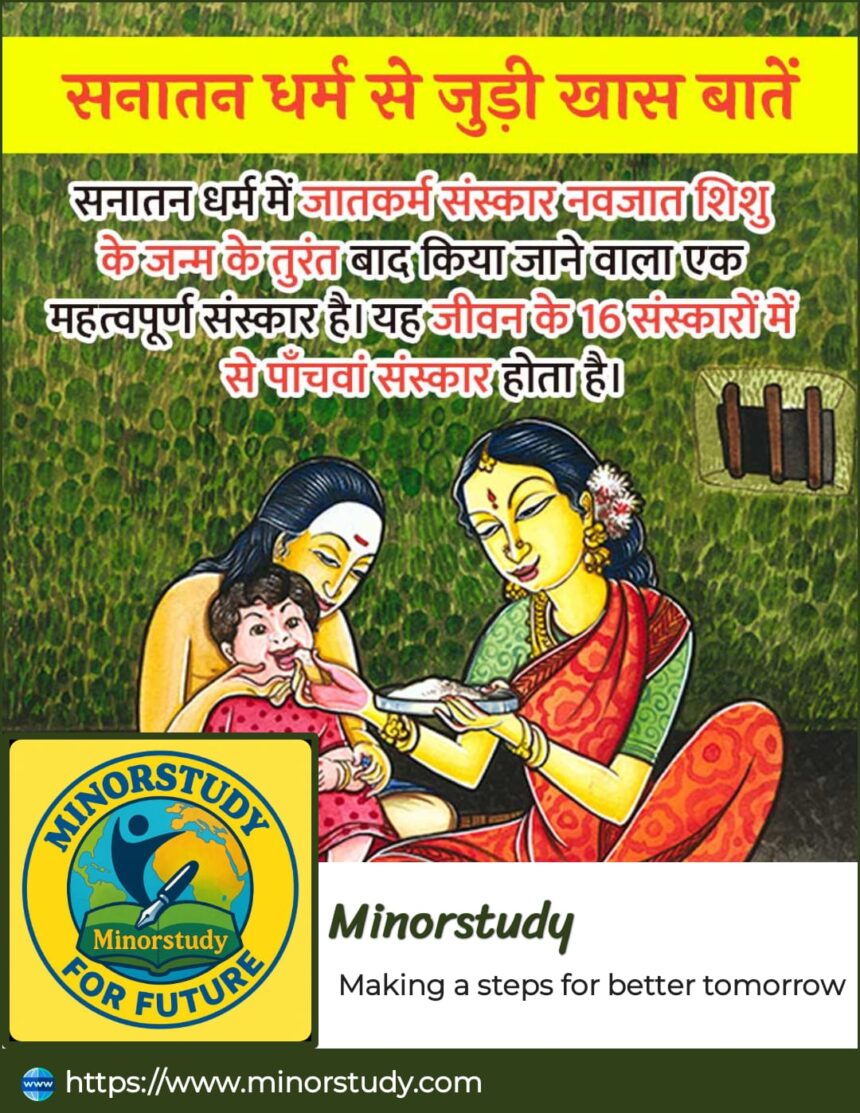🌼 9 Divine Facts About Jaatkaram Sanskar That Will Deeply Touch Your Soul
Sanatan Dharma—the eternal, ever-living way of life—places immense importance on every stage of human life, right from conception to death. Within this framework lies a profound set of 16 sacraments, known as “Shodasha Samskaras”, designed to sanctify and guide human life in its entirety. One of the earliest and most vital among these is the Jaatkaram Sanskar, the fifth Samskara, performed immediately after the birth of a child.
- 📜 What Is Jaatkaram Sanskar?
- 🕉️ Historical Context of Jaatkaram Sanskar
- 📅 Timeline: When Is It Performed?
- 🔍 9 Powerful Facts About Jaatkaram Sanskar
- 1. 🌿 First Sacred Act of Dharma
- 2. 👂 Whispering the Gayatri or God’s Name
- 3. 🍯 Honey and Ghee Offering (Medhajanana)
- 4. 🧬 Genetic & Spiritual Purification
- 5. 👨👩👧 Connecting Child to Family & Ancestors
- 6. 🧠 Opening the Inner Ear of Dharma
- 7. 📿 Chanting of Mantras for Protection
- 8. 🤱 Mother and Child Bonding Ritual
- 9. 🌏 Universal Yet Personal
- 🙏 Ritual Observance: Step-by-Step
- 💡 FAQs: All About Jaatkaram Sanskar
- Q1. Why is Jaatkaram important in Sanatan Dharma?
- Q2. Can it be done at home?
- Q3. Is it compulsory?
- Q4. Can modern medicine and Jaatkaram co-exist?
- Q5. Can both parents perform the ritual?
- 💫 Significance in Our Daily Life
- 🎉 Wishing and Celebrating Jaatkaram Sanskar
- 🧭 Why It’s Important for Society
- 🧘♂️ Conclusion: Jaatkaram Is the Whisper of Dharma into Life’s Ear
In this article, we explore the history, facts, FAQs, rituals, societal significance, spiritual depth, and day-to-day relevance of the Jaatkaram Sanskar in a deeply human, warm, and relatable tone.
📜 What Is Jaatkaram Sanskar?
Jaatkaram (also spelled Jatakarma or Jatakarman) is the birth sacrament—the ritual performed right after a child’s birth. The word “Jaat” means birth and “Karma” means action or deed. Hence, Jaatkaram Sanskar refers to the rites performed to welcome and purify the newborn.
It is not just a ritual; it’s a sacred introduction of the soul into the physical world and a symbolic celebration of the divine spark of life.
🕉️ Historical Context of Jaatkaram Sanskar
Vedic Roots: Jaatkaram has been mentioned in ancient scriptures like the Grihya Sutras, Manusmriti, and Smriti Granthas.
Rishi Traditions: In the Vedic age, sages like Vasishtha and Atri performed Jaatkaram as the very first step of instilling Dharma into the newborn.
Symbolism: The ritual represents the soul’s formal entry into society, connecting it with Dharma, family, and cosmic consciousness.
📅 Timeline: When Is It Performed?
| Stage | Timeframe | Purpose |
|---|---|---|
| Immediately after birth | Within 10-12 hours | Spiritual protection, purification |
| After cutting umbilical cord | Same day or next | Welcoming the child and guiding consciousness |
| Combined with Naamkaran | Sometimes on the 10th or 12th day | To merge rituals if needed |
🔍 9 Powerful Facts About Jaatkaram Sanskar
1. 🌿 First Sacred Act of Dharma
This ritual marks the newborn’s first encounter with Dharma. Before the child even speaks, righteousness is spoken into its ears, preparing the mind and soul for spiritual awakening.
2. 👂 Whispering the Gayatri or God’s Name
Traditionally, the father or a priest whispers Om, Gayatri Mantra, or the name of God into the right ear of the baby. This symbolizes the activation of divine consciousness.
3. 🍯 Honey and Ghee Offering (Medhajanana)
A sacred mix of honey and ghee is placed on the tongue of the baby to enhance intellect (medha) and signify the sweetness and strength of the life ahead.
4. 🧬 Genetic & Spiritual Purification
The Jaatkaram is both symbolic and scientific—purifying the environment, blessing the genes, and spiritually acknowledging the baby’s divine origin.
5. 👨👩👧 Connecting Child to Family & Ancestors
Prayers are offered to Pitrs (ancestors) and Ishta Devata (personal deity) to bless the newborn. It’s a way of welcoming the soul into the lineage.
6. 🧠 Opening the Inner Ear of Dharma
The right ear is specifically chosen to symbolize the inner ear of wisdom—a metaphor for lifelong learning and righteousness.
7. 📿 Chanting of Mantras for Protection
Mantras such as Gayatri, Mahamrityunjaya, and Vedic hymns are chanted to invoke divine protection, long life, and good health.
8. 🤱 Mother and Child Bonding Ritual
This sanskar often involves offering prayers for the mother’s health and ensuring the baby is nursed in a calm, sacred atmosphere, emphasizing mental peace.
9. 🌏 Universal Yet Personal
While rooted in Sanatan Dharma, the Jaatkaram reflects a universal message—the sacredness of birth, the importance of values, and the divine nature of human life.
🙏 Ritual Observance: Step-by-Step
Cleaning the baby with warm water and natural antiseptics like turmeric or neem (optional).
Father or Purohit recites Vedic Mantras invoking deities.
Whispering Om/God’s name into baby’s right ear.
Feeding a drop of honey and ghee to the baby.
Blessings from elders—touching the head with love and prayers.
If possible, Naamkaran Sanskar is planned within 10–12 days.
💡 FAQs: All About Jaatkaram Sanskar
Q1. Why is Jaatkaram important in Sanatan Dharma?
It purifies, protects, and spiritually strengthens the newborn, connecting the child with Dharma from the very beginning of life.
Q2. Can it be done at home?
Yes, traditionally done at home with a family priest (Purohit) or a learned elder. Simplicity and sincerity matter more than scale.
Q3. Is it compulsory?
While not legally binding, it’s considered highly auspicious and spiritually essential in Vedic tradition.
Q4. Can modern medicine and Jaatkaram co-exist?
Absolutely. Jaatkaram is spiritual and symbolic. It doesn’t replace post-natal care—it complements emotional, mental, and spiritual well-being.
Q5. Can both parents perform the ritual?
Traditionally, the father performs it, but both parents can be involved, especially in today’s family-centric rituals.
💫 Significance in Our Daily Life
Even though it’s a one-time ritual, the impact of Jaatkaram lasts a lifetime:
Creates positive vibrations around the baby from day one.
Instills values of spirituality, gratitude, and purity.
Strengthens the bond between child, family, and cosmos.
Sets a Dharmic tone for the child’s future actions and decisions.
Reminds families of their role in nurturing a spiritual legacy.
🎉 Wishing and Celebrating Jaatkaram Sanskar
“May your newborn’s Jaatkaram Sanskar bring divine blessings, wisdom, and a life filled with joy, purpose, and Dharma. Welcome to the world, little soul!”
This occasion is celebrated with:
Light decoration and flowers
Chanting and quiet spiritual music
Distribution of sweets or homemade prasad
Sharing the ritual with close friends and family
🧭 Why It’s Important for Society
In a fast-moving, digital world, Jaatkaram Sanskar reconnects us to roots:
Encourages mindful parenting
Strengthens intergenerational bonds
Celebrates birth not just biologically, but spiritually
Reinforces community values of care, love, and respect
It reminds us that every child is a divine gift, not just a biological event.
🧘♂️ Conclusion: Jaatkaram Is the Whisper of Dharma into Life’s Ear
In Sanatan Dharma, life is sacred from the very first breath. The Jaatkaram Sanskar whispers this eternal truth into the ears of a newborn—guiding the soul, celebrating the spirit, and embedding values that last for a lifetime.
Let us not see it as a mere ritual, but as an opportunity to welcome life with full awareness, devotion, and grace.
As parents, teachers, or citizens of this eternal culture, we must preserve and understand such sacred traditions—not just for their form, but for their inner meaning.








